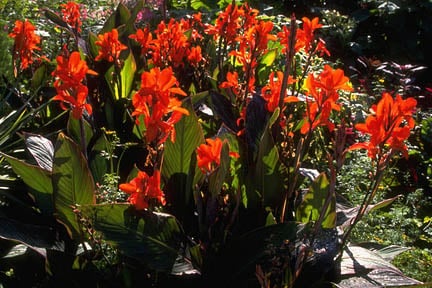
Quick facts
Common name - Canna
Latin name - Canna
Group - Tender perennial
Flowering time - June to October outside
Planting time - March and April
Height and spread - 1.8m (6ft) by 1m (3½ ft)
Aspect - Sunny
Hardiness - Tender
Difficulty - Moderate
Cultivation notes
Cannas can be grown in borders or containers. They are grown from (underground stems), which you will find for sale in late winter in bags of shredded paper, or sold loose. Cannas are easy to grow from rhizomes, but you can also buy plants over the summer.
They are tender plants, but in warmer parts of the UK you can leave the rhizomes in the ground with a covering of .
Starting off rhizomes
Start rhizomes off into growth in March or early April by planting in 20cm (8in) pots using multi-purpose . The rhizomes should be just covered with compost, leaving any young shoots exposed. Water lightly. Keep the rhizomes at a temperature of 10-16°C (50-60°F), such as in a heated greenhouse or sunny conservatory. If heating is not available, delay potting until April. Increase watering as growth develops.
Planting in borders and containers
Move the plants to a cool greenhouse in mid-April and gradually before planting out at the end of May (or when the last frosts have past).
Plant about 75cm (30in) apart, 10cm (4in) deep. In borders, choose a sheltered, sunny spot and soil that has been improved by digging in well-rotted manure or garden compost. Also apply a general purpose fertilizer, such as growmore, at 70g per sq m (2oz per sq yd).
If growing in containers, use one at least 30cm (1ft) wide. Fill with a John Innes No. 3 loam-based compost and add a controlled-release fertiliser. Plant the rhizomes at the same depth as in borders (see above).
Aftercare
To help keep your cannas healthy;
- Water freely in dry spells
- Apply a liquid fertiliser in midsummer
- to encourage continued flowering
- Little pruning or training is needed. Just stake clumps in exposed positions
- When a flower spike has no more , prune it down to the next side shoot where a secondary flower spike should develop
- Under glass, grow in full light but shade from hot sun. If temperatures are maintained above 10°C (50°F) cannas will remain in growth all winter and flower occasionally
Overwintering
In mild areas: Plants can be left outside all year in a sunny, sheltered position. However, apply a 15cm (6in) deep layer of in winter and be prepared that there may be losses in very cold or wet winters.
In colder areas: Pot-grown specimens can simply be moved into a frost-free place. Otherwise, lift the once the top growth begins to wither in autumn. Cut down the foliage and stems to about 15cm (6in). Remove surplus soil, dry and then store in trays in barely-damp wood or multi-purpose . Place in a frost-free position for the winter. Little, if any, watering should be necessary.
Water canna
In summer, water cannas (often bred from Canna glauca) can be placed in containers in ponds with no more than 15cm (6in) of water over the roots. They are also suitable for well-watered borders or conservatories where potted plants can be stood in deep saucers of water.
Before autumn frosts, bring plants from outdoors into a frost-free greenhouse or conservatory. Keep the pots moist but not saturated. In April, increase temperatures and plant the sprouted plants out in late May when the risk of frost has passed.
Propagation
Cannas can be propagated in spring by division of the into sections, each with two or three growing points. Cannas can also be propagated from seed, although cultivars will not come true. In a good summer, many cannas will set seed that can be sown the following spring. Seed-raised plants usually flower in their second year.
If sowing seed, follow these tips for the best results:
- To speed , soak seed in warm water for 48 hours or make a small nick in the seed-coat prior to sowing in multipurpose at 21°C (70°F). Cover the seed with their own depth of compost
- Pot on soon after germination into individual containers
- Keep at a temperature of about 16°C (60°F)
Cultivar selection
Garden hybrids
Canna 'Striata' AGM: Golden-striped green leaves and orange flowers. Height 1.9m (6ft)
C. ‘Phasion’: Striped leaves, orange flowers. Height 1.6m (5½ft)
C. ‘Picasso’ AGM: Green or blue-ish leaves, yellow flowers spotted with red. Height 1.5m (5ft)
C. ‘Wyoming’: Bronze leaves, orange flowers. Height: 2.3m (8ft)
Water cannas
C. ‘Endeavour’: Raspberry red. Height 1.8m (6ft)
C. ‘Erebus’: Salmon pink. Height 1-1.2m (3-4ft)
C. ‘Ra’ AGM: Lemon yellow. Height 1.8m (6ft)
Links
Problems
A common problem is non-flowering. This is usually due to starting the into growth late, but can also be caused by a lack of water or poor soil fertility.
Plants can be infected with virus, which may be indicated by distorted foliage, or a yellow streaking, or mosaic pattern on the leaves. There is no cure for viruses and infected plants should be destroyed.
Other problems include usual garden pests such as glasshouse red spider mite, aphids, slugs and snails.


